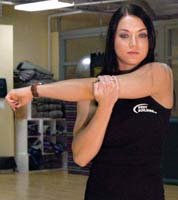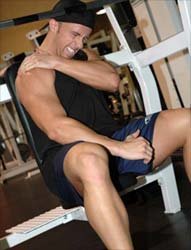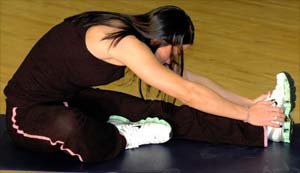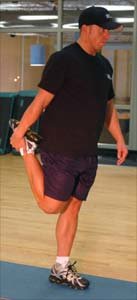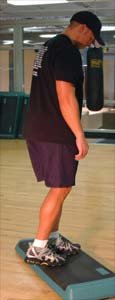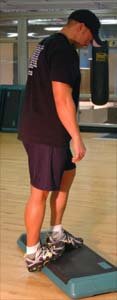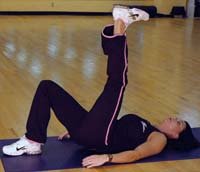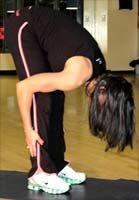The range of motion available in a joint is referred to as flexibility. It is extremely important in fitness and wellness. Flexibility is specific to each joint, meaning a person might be flexible in shoulder joint movements and tight in hip joint movements. Joint structure, age and sex are factors that affect flexibility that cannot be altered by flexibility training.
The entire musculoskeletal system benefits from having good flexibility. Flexibility is essential to normal joint health. Tight quadriceps muscles can lead to joint discomfort and cause knee pain. If the shoulder joint is subjected to abnormal stresses by being tight, it can result not only in restricted mobility but can irritate the soft tissues.
Increased flexibility can greatly improve your posture and quality of life. This is particularly true for older people; improved tissue elasticity helps to facilitate movement.
There is a trade-off between joint stability and flexibility. If a joint is highly stable, has too little flexibility, you are more prone to an injury of the muscle, tendon, and ligament surrounding the joint. If a joint has too much flexibility and is less stable, you are more likely to suffer dislocation-type injuries. Moderation is key to safe training. In general, a joint should be able to move freely in all anatomical planes appropriate for that joint.
Weight training can improve flexibility. Both men and women have successfully increased their flexibility by being active in a resistance training program. For improvement to incur, you need to follow a balanced exercise program for all of the opposing muscle groups and the exercises must be performed through a full range of motion. Dumbbells may contribute more to flexibility because they allow the greatest range of motion.
Besides weight training, stretching is an effective way to improve flexibility. The range of motion of a joint can be enhanced by stretching the soft tissue surrounding it; the muscles, tendons and ligaments. The soreness you can experience post-workout can also be greatly reduced by stretching. Stretching exercises can be performed in different ways including:
- Static
- Ballistic
- Proprioceptive neuromuscular facilitation (PNF)
1. Static Stretching
Most people do some form of static stretching and is what most mean by the term flexibility. For example, static hamstring flexibility would determine how far you could reach toward your toes in a seated position with your legs extended.
Static stretching is slow and constant with the end position held for 10-30 seconds. A slow and smooth stretch prompts less reaction from stretch receptors and is safe. Holding the stretch longer than 10 seconds allows for the muscle spindles to relax and be less sensitive.
Muscle Spindles: Muscle spindles are found within the fleshy portions of muscles, embedded in so-called extrafusal muscle fibres. Their functions are to send proprioceptive information about the muscle to the central nervous system, and to respond to muscle stretching.
Stretching statically should be done to the point of mild discomfort, where a pull is felt, but not to a point of pain. Never bounce while stretching because it increases the risk of injury. After holding the stretch, slowly return to the start position and rest 30-60 seconds before repeating. Muscle spindle activity decreases greatly when doing a stretching exercise several times in a row. I recommend performing the stretch 1-3 times.
Static stretches can be performed either passively or actively. Passive stretching requires an outside force to move your joints through their range of motion. The outside resistance can be from yourself, a partner or even gravity. You can achieve a greater range of motion passively stretching, but there is also a greater risk of injury due to the stretch not being controlled by the muscles themselves.
In active stretching, the muscle is stretched by contracting the opposing muscle group. Stretching the calves, for instance, can be done by contracting the muscles on top of the shin (tibulus anterior). The contraction of the antagonist muscle produces a reflex that relaxes the muscles to be stretched. This type of stretching is safer but it may not produce enough stretch to increase flexibility.
Take advantage of both active and passive stretching by implementing both at the same time. For example, you can stretch your calves by dropping your heels down while standing on a block and at the same time actively contract your tibulus anterior. This way you have the safety and relaxation reflex of an active stretch and the greater range of motion with a passive stretch.
2. Ballistic Stretching
Ballistic stretching involves the muscles being stretched suddenly in a bouncing-type movement with active muscular effort. The end position is not held as in static stretching. Ballistic stretching is not recommended because it may injure muscles or connective tissues. It also causes a heightened activity of the muscle spindles not allowing the muscle to relax, which defeats the purpose of stretching.
3. PNF Stretching
PNF stretching techniques require a muscle to be contracted before it is stretched. It usually requires a partner and takes more time than static stretching. It requires more expertise and involves both passive and active movement. However, PNF stretching methods may be more superior to static stretching because they facilitate muscular inhibition (reciprocal and autogenic inhibition).
The hold-relax and contract-relax techniques for PNF are essentially the same, where one entails the muscle to contract isometrically and the other concentrically before being stretched.
For example, PNF stretching can be done for the hamstring muscles. When lying down, a partner applies a force to one leg until at the point of mild discomfort. This is the first resistance barrier and it is held passively for 10 seconds.
Then the person being stretched is either instructed to hold the leg in place while the partner attempts to gently move the leg forward (hold-relax technique) or move the leg forward while the partner resists the movement (contract-relax technique).
The isometric or concentric contraction is held for a total of 6 seconds. The person being stretched is then instructed to relax and the partner moves the leg to the second resistance barrier. The stretch is of greater magnitude due to autogenic inhibition, or activating the hamstring muscles.
A passive stretch is performed here again, this time for 30 seconds. You can contract the antagonist muscle here, as in active stretching; in this case you would contract the hip flexors.
You can repeat the stretch sequence and move to the third resistance barrier or slowly lower the leg back down. I recommend performing PNF stretches slowly to achieve maximum benefits and reduce the risk of injury, 1-3 times on both sides of the body.
Conclusion
The American College of Sports Medicine (ACSM) recommends that stretching exercises be performed a minimum of 2-3 days per week. For even greater benefits, flexibility training can be done more often; static stretching can be performed up to 7 days per week. Stretching should be done after a proper warm-up.
It is best to stretch when muscles are warm. A good analogy of stretching a cold muscle is to think of a rubber band being stretched that is cold. What happens? It snaps and that is exactly what you don't want when stretching.
If the rubber band is warm, then it is far more elastic. So before doing your stretching exercises, be sure to do a light 5-10 minute cardio warm-up beforehand. This will warm your connective tissue and prevent muscle and tendon tears or pulls while stretching.
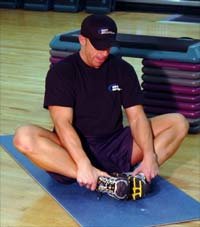
 Click Image To Enlarge.
Click Image To Enlarge. A Good Time To Stretch Is Post-Workout
Because Of Your Increased Muscle Temperature.
Stretching prior to resistance exercise decreases the likelihood of injuries, particularly muscle strains. It increases the range of motion of the joints being trained. Another good time to stretch is post-workout because of your increased muscle temperature.
The increased temperature allows for a greater stretch magnitude, because it increases the elastic properties of collagen within muscles and tendons. Stretching after your resistance training may also reduce muscular soreness.
Self-myofascial release is another stretching technique that focuses on the neural system and fibrous tissue of the muscle. It is another way to create autogenic inhibition, decreasing the muscle spindle excitation. It involves the application of gentle pressure to a muscle "knot" or tender spot that indicates muscle tightness, often with the use of a foam roller.
Self-Myofascial Release Self-Myofascial Release is a form of bodywork (alternative medicine) which includes, but is not limited to structural assessments (where a formal diagnosis is not necessarily given) and manual massage techniques for stretching the fascia and releasing bonds between fascia, integument, muscles, and bones are mainly applied; with the goal of eliminating pain, increasing range of motion and balancing the body.
You lie on the ground and place the foam roll under the muscle that is tight. Then slowly roll on the foam to find the most tender spot. Once identified, the position should be held in place for a minimum of 20-30 seconds or until the discomfort is reduced by 75 percent. Then you progress to the next tender spot and hold again.
The process of self-myofascial release alters the muscle fibers from a bundled position into straighter alignment with the direction of the muscle and/or fascia. It helps to restore the body to its optimal level of function. This technique is best done after static stretching, pre or post-workout.

